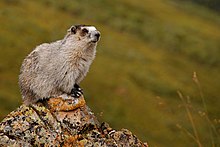| Hoary marmot | |
|---|---|

| |
| Scientific classification | |
| Domain: | Eukaryota |
| Kingdom: | Animalia |
| Phylum: | Chordata |
| Class: | Mammalia |
| Order: | Rodentia |
| Family: | Sciuridae |
| Genus: | Marmota |
| Subgenus: | Marmota (Petromarmota) |
| Species: | M. caligata
|
| Binomial name | |
| Marmota caligata (Eschscholtz, 1829)
| |
The hoary marmot (Marmota caligata) is a species of marmot that inhabits the mountains of northwest North America. Hoary marmots live near the tree line on slopes with grasses and forbs to eat and rocky areas for cover.
It is the largest North American ground squirrel and is often nicknamed "the whistler" for its high-pitched warning issued to alert other members of the colony to possible danger. The animals are sometimes called "whistle pigs". Whistler, British Columbia, originally London Mountain because of its heavy fogs and rain, was renamed after these animals to help make it more marketable as a resort.[3] The closest relatives of the species are the yellow-bellied, Olympic, and Vancouver Island marmots, although the exact relationships are unclear.[4][5]
- ^ Cassola, F. (2018). "Marmota caligata". IUCN Red List of Threatened Species. 2018: e.T42456A122560084. doi:10.2305/IUCN.UK.2018-2.RLTS.T42456A122560084.en. Retrieved 11 November 2021.
- ^ IUCN (International Union for Conservation of Nature) 2008. Marmota caligata. In: IUCN 2014. The IUCN Red List of Threatened Species. Version 2014.3. http://www.iucnredlist.org Archived 2014-06-27 at the Wayback Machine. Downloaded on 25 February 2015.
- ^ BritishColumbia.com Archived 2007-04-04 at the Wayback Machine – Whistler, British Columbia
- ^ Kruckenhauser, L.; et al. (1999). "Marmot phylogeny revisited: molecular evidence for a diphyletic origin of sociality". Journal of Zoological Systematics and Evolutionary Research. 37 (1): 49–56. doi:10.1046/j.1439-0469.1999.95100.x.
- ^ Steppan, S.J.; et al. (1999). "Molecular phylogeny of the marmots (Rodentia: Sciuridae): tests of evolutionary and biogeographic hypotheses". Systematic Biology. 48 (4): 715–34. CiteSeerX 10.1.1.333.3029. doi:10.1080/106351599259988. PMID 12066297.
